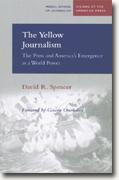The Yellow Journalism
David R. Spencer
book reviews:
· general fiction
· chick lit/romance
· sci-fi/fantasy
· graphic novels
· nonfiction
· audio books
· author interviews
· children's books @
curledupkids.com
· DVD reviews @
curledupdvd.com
newsletter
win books
buy online
links
home
for authors
& publishers
for reviewers

 |
The Yellow Journalism: The Press and America's Emergence as a World Power David R. Spencer Northwestern University Press Paperback 304 pages February 2007 |
|
Itís no secret that journalists and the media in general are not the most well-liked in todayís political climate. However, this is not the first time the field of journalism was looked down upon, as evident in David R. Spencerís thoughtful book The Yellow Journalism
Spencer goes beyond the familiar topics of the inaccurate coverage of the Spanish-American War and Hearstís flamboyancy to set the tone for how yellow journalism and the daily paper developed. The history of the newspaper is quickly yet thoroughly discussed in order to show the natural progression of the freedom of the press to include sensationalism. Spencer highlights the growing partnership between the business world and publishers through the emergence of advertising and the importance of technology throughout the book from the penny press to lithography. The invention of the telegraph, for example, played a pivotal role in yellow journalism since it was the method of communication that allowed newspapers to expand their coverage beyond state and national borders. This was also the era where the use of graphics and comics became a staple for newspapers. Interesting accompanying illustrations in the book along with a thorough analysis provide a sampling of the growing popularity of political cartoons. The backdrop of yellow journalism is vividly described, with the social contrasts between the rich and the poor growing in the late Victorian Era with the obsession of moral standards and the indulgence of the rich (particularly corrupt politicians) filling the pages of newspapers. Though Spencer focuses almost exclusively on New York, he does briefly describe how yellow journalism could be argued to be mostly an East Coast phenomenon, with Midwestern newspapers like the Chicago Record and the Chicago Daily News condemning sensationalism. Spencer wisely includes an analysis of various journalism styles that prevailed during the yellow journalism era. This is where crime reporting went to the extreme. At one point, Hearst hired a team of investigate journalists solely for crime reporting, a concept not unusual in todayís newsrooms. Gruesome details of crimes were not uncommon, including graphic drawings of dismembered bodies. Hearst also ushered in the importance of science reporting though the publication The American Journal, which regularly published illustrations of the latest inventions. Surprisingly, there was also a growth in ďfree loveĒ publications advocating sex education and common-law relationships. Due to the crackdown of these publications from moral advocate Anthony Comstock, sex was not allowed in newspapers and therefore explains why newspapers leaned on crime reporting to sell their sensationalist and lucrative stories. Sensationalism marked a shift in journalism during the turn of the 20th century, most notably in the coverage of the Spanish-American War. Spencer describes the concept of objectivity in journalism and how that nearly ceased to exist in yellow journalism, particularly war coverage. He argues that the Monroe Doctrine of divine approval for expansionism was gaining prominence in the political landscape leading up to the Spanish-American War and was one of the reasons why Hearst encouraged a U.S. intervention in Cuba through his newspapers. Spencer demonstrates that not all of Hearstís reporting was fabricated with the story of Hearstís New York Journal investigation into Spanish ambassador Dupuy de Lome. There are plenty of anecdotes, analysis, and explanation in The Yellow Journalism Despite these setbacks, Spencer fulfills his main goal as mentioned in the opening pages: ďThis volume is intended to complement the fine work already undertaken on the Yellow Press.Ē Originally published on Curled Up With A Good Book at www.curledup.com. © Julie Sobowale, 2007 |
|
|
|
 Click here to learn more about this month's sponsor! |
|
| fiction · sf/f · comic books · nonfiction · audio newsletter · free book contest · buy books online review index · links · · authors & publishers reviewers |
|
| site by ELBO Computing Resources, Inc. | |
 This book is the latest release in the acclaimed Medill School of Journalismís book series ďVisions of the American Press.Ē As a first-time author, Spencerís timely book does fairly well in explaining the complex and humorous interactions between publishers and journalists, including the well-documented rivalry between William Randolph Hearstís New York Journal and Joseph Pulitzerís The World during the rise of the daily newspaper in the American Gilded Age.
This book is the latest release in the acclaimed Medill School of Journalismís book series ďVisions of the American Press.Ē As a first-time author, Spencerís timely book does fairly well in explaining the complex and humorous interactions between publishers and journalists, including the well-documented rivalry between William Randolph Hearstís New York Journal and Joseph Pulitzerís The World during the rise of the daily newspaper in the American Gilded Age.